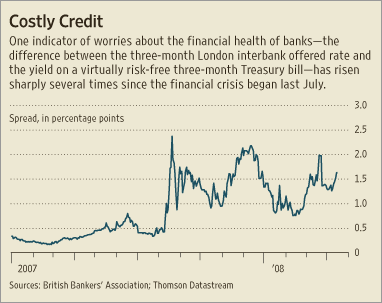Traders,

As we come back from a long holiday weekend we revisit the reality of higher oil prices and gas prices. The weekend financial news was loaded with oil stories and as long as prices remain higher it will continue to the be the focus. The confrontation of the CEO’s of the oil companies by our government made for some interesting T.V. but really can’t do much to solve the oil problem.
It is ironic that our government attacks the oil companies for making profits, since they do NOT determine the price of oil. What is even more interesting that everyone failed to bring up is that oil companies are owned (in majority) by retail investors – either directly (about 25% of the outstanding shares) and pension funds (about 30% of outstanding shares) any tax or curtailing of their 6-8% profit margin – will actually hurt the shareholders as well.
The continual assumption that it is speculators that have driven the price of oil thus far continues to make little sense to me. It’s as if these people have no understanding of how oil futures work. Every 30 days oil future contracts convert to ACTUAL oil. That means if you HOLD a oil contract you HAVE to take delivery of oil (you don’t get a choice in that matter). So IF the price of oil was driven solely by all these speculators – they would ALL have to sell those contracts within 30 days – which if it was totally driven by speculators, would we see a HUGE pull back in the future price as ALL THOSE speculators (who do NOT plan to take delivery of oil) SELL oil? While I don’t deny that rolling to the next month is an option – and there has been an increase in the calendar spreads – it is not to the level as those making accusations that oil speculators are the sole reason why oil has risen. No doubt there is oil speculation – there has and always will be – but if the rise in price was solely predicated on speculators – we would see oil fall dramatically every 30 days as those speculators are FORCED to sell their contracts or take delivery.

No doubt ETFs help drive those prices as well – but notice the disparity in price (down in some cases over 25% compared to current spot price) – there is also a LOT of short interest in those ETF contracts as well – as “Speculators” are ALSO trying to call a top and SHORT the ETF. Oil is a complex commodity, it is a finite commodity, a depleting commodity, it is refined into multiple products, it IS the life blood of every industrialized country. I think oil will pull back – and probably sometime in the near future, but I would NOT call a top at any price (because of its complexity and volatility) and I would further firmly believe that any pull back does not mean the long-term trend is only going to continue higher. Oil sands and shell will eventually help the supply line – but the technology and deliverable speed is still in the beginning – the question for those speculating in those ventures as a increase supply line and eventually bring oil prices down, is that can it’s delivery match the global consumption rate increase – by the time it does come online.
__________________________________________________
LIBOR rate still causing concern and volatility
The LIBOR is a benchmarked for about $350 TRILLION of debt-related securities according to the Bank for International Settlements – reported by Bloomberg. For example AT&T (the biggest U.S. phone company) pays on $2 billion of notes it sold on March that floats at a 3 month Libor rate plus .45 percentage points. It IS one of the intrinsic factors in the world’s financial lending system and any movement in the rate has world-wide ramifications.
 In an interesting revealing article by Bloomberg the importance and method of Libor becomes clear. Every morning the an unregulated trade group asks the member banks how much it would cost them to borrow from each other for 15 different periods (from overnight to one year). The rate is in currencies (including Dollars, Euros, Pounds, etc.).It then calculates averages, throwing out the four highest and lowest quotes and then publishes at 11:30 am London time. The 3-month dollar Libor rate was set at 2.64% this morning.
In an interesting revealing article by Bloomberg the importance and method of Libor becomes clear. Every morning the an unregulated trade group asks the member banks how much it would cost them to borrow from each other for 15 different periods (from overnight to one year). The rate is in currencies (including Dollars, Euros, Pounds, etc.).It then calculates averages, throwing out the four highest and lowest quotes and then publishes at 11:30 am London time. The 3-month dollar Libor rate was set at 2.64% this morning.Libor became the talk last August when the sub-prime problem begin to surface, as world banks had been involved in making sizeable investments. Banks were suddenly wary of lending to each other because of the mounting losses (that reached over $350 billion as of last week). The 3-month Libor rate climbed 2.40 percentage points ABOVE yields on the Treasury Bills (the widest margin since 1987).
Now Libor methodology is coming into question and is starting to be pointed to as an additional cause to the credit crisis and problems. Many feel the need for MORE regulation on how Libor is set and published. From banks making their bids anonymously to moving the release time to 10 AM New York time (which would favor the US markets rather than the current skew towards Europe) – however only 3 U.S. banks contribute rates for the Libor numbers (Citi-group, B of A, and JP Morgan).
However, these changes need to be seriously reviewed as any changes in method could INCREASE volatility and may cause fewer banks to participate. Additionally – some of the changes may just be cosmetic and offer no real adjustments. For now it will continue to be used to set prices and a major measuring tool as to the credit health of the market.
__________________________________________________
More data this week – first housing
New home sales are expected to decline further this month and through-out the summer. The Case-Shiller just reported that U.S. metropolitan area home prices plunged 14.4% (more than economist expected) from a year earlier. The most since the index was first published in 2001. Analyst expect it to increase at-least through the end of the year.
RealtyTrac reported that foreclosure filings continue to increase and were up 65% in April from a year earlier. Expectations of foreclosures are for a continued increase through 2008 as the process for foreclosures and some states/cities have even curtailed the process – meaning that it will be a continue trickling increase.

Sales of existing homes (previously owned) which account for 85% of the market, fell 1% in April and the supply for unsold properties reached a record – reported by the National Association of Realtors.
``We continue to expect the U.S. housing market to get slightly worse before it gets better,'' Stephen Webster, the company's finance director, said in a conference call with journalists last week. ``We would like to see a few months of stable housing starts or increasing housing starts before we call the bottom.''
Additional data will be coming out this week and should send some upside and downside jolts to the market. Some would expect some pressure in the home sectors in the market – but don’t be surprised if we again see some bottom picking “the worst is behind us” mentality. For now – be wary of taking long hard delta positions in the home sectors – unless hedged.
_________________________________________________
Other News
 Heavy put option trading in Leman and the massive increase of OTM put volatility has Dr. J issuing concerns that many are expecting another Bear Stearns – if the option paper is any indication.
Heavy put option trading in Leman and the massive increase of OTM put volatility has Dr. J issuing concerns that many are expecting another Bear Stearns – if the option paper is any indication.BUD a target take-over – there are some rumors swirling about?
Lehman, Goldman, Morgan estimates are cut by Bank of America.
________________________________________________
Futures Pre-open
The futures were flat to down in the pre-market and then oil started pulling off pretty hard (already down $1.5) and is sending a good jolt to the futures. They are currently front running the cash by a couple of points. If oil continues to fall into the opening – expect Arb traders to leg into the short-futures and long cash basket. This could put some upside pressure on the indices at the opening.
_______________________________________________
Support / Resistance
The market had another big pull-back on Friday and broke the short-term supports. It looks like it is getting a boost in the AM from the pull back in oil. But at this point the action is more speculative based on Oil than anything else.
INDU 12250 / 12800 (We broke that 12600 short-term support and it is possible we could get a rally to move above it going forward. But Europe is down and while oil is pulling off sending the futures higher in the pre-market – this index is in a volatile area that could make quick moves up or down from this point. It may stall at 12600 which WAS a short-term support.)
NDX 1950 / 2000 (This index kept from falling to much from the huge move by over-weight AAPL that was up $4 on Friday which is about 5-6 points in the index. Again keep an eye on the big movers in this index to get an idea of this more volatile index.)
SPX 1380 / 1400 (We got down through the 1380 support area and looks like we may get above it at the opening. Can we close above it and get some strength to return?)
RUT 720 / 740 (We touched 720 and bounced on Friday – showing some strength in the broader market. Keep an eye on 720 – if we revisit it again and do NOT bounce it could pull down on the entire market.)
____________________________________________
Conclusion
The market is getting some volatility from oil – which is pretty volatile and creating inversion moves in the financial futures. The housing market – and Case-Shiller – along with other reports – continue to show more downward pressure in the housing market. The Libor is also a concern and volatility has not been abated as of now. The continued volatility in the market place is not reflective in the VIX – which I think should be in the mid 20s if it is any sign of what is going on. It clearly shows that there is NO fear in the market from investors side – that maybe continuing to call a top in oil and a bottom in the market.
The dollar continues to remain weak and gives back any gains that it makes (1 step forward – 2 steps back).

For now remain skeptical and hedge assets.


No comments:
Post a Comment